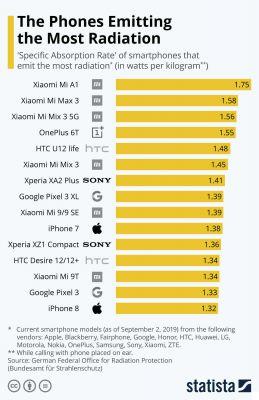A German body, CENELEC (European Committee for Electrotechnical Standardization) is responsible for regulating the acceptable values and limits of electromagnetic radiation from electronic devices. The maximum limit set is 2.0 W / kg measured on 10 grams of fabric. Measurements are made by holding the smartphone next to the test dummy's ear and deliberately bringing the values to maximum. Subsequently, on the basis of these data, a ranking is drawn up on the devices with the highest values.
However, we would like to clarify that the emissions measured always concern the spectrum of where radio, which is a type of non-ionizing electromagnetic radiation. Unlike ionizing waves (such as x-rays used in medicine or the UV rays of solar radiation), non-ionizing radiation they do not have the power to modify DNA, with the consequent increased risk for cancers of various kinds. Furthermore, other mechanisms that could damage our health, at least to the powers of interest, have not yet been ascertained. Emission measurements from smartphones are therefore carried out in a regulatory framework precautionary, to comply with a legal limit set not so much for a known risk, but to be absolutely sure that we are not exposing consumers to as yet unknown risks.
READ ALSO: Best smartphone | January 2020: the Tech Princess guide
Cellular radiation: the ranking
We have at least 15 smartphone to be reported among the most "radioactive" at the beginning of 2020. We are talking about devices that do not exceed the thresholds allowed in Europe, but which at the same time require in-depth analysis, especially for some smartphones Huawei e Xiaomi, particularly widespread in Italy. A little attention also to the models of iPhone older and some smartphones OnePlus. Instead, Samsung, as already demonstrated in past years, it proves to be one of the brands most attentive to the problem. Here is the ranking:
- Xiaomi Mi A1 with a value equal to 1,75 Watt per kg
- OnePlus 5T with a value equal to 1,68 Watt per kg
- Huawei Mate 9 with a value equal to 1,64 Watt per kg
- Xiaomi Mi Max 3 with a value equal to 1,58 Watt per kg
- OnePlus 6T with a value equal to 1,55 Watt per kg
- HTC U12 Life with a value equal to 1,48 Watt per kg
- Honor 8 with a value equal to 1,5 Watt per kg
- Huawei P9 Plus with a value equal to 1,48 Watt per kg
- Motorola Moto Z2 Play with a value equal to 1,455 Watt per kg
- Xiaomi Mi Mix 3 with a value equal to 1,45 Watt per kg
- Huawei GX8 with a value equal to 1,44 Watt per kg
- Huawei P9 with a value equal to 1,43 Watt per kg
- Huawei Nova Plus with a value equal to 1,41 Watt per kg
- Google Pixel 3 XL with a value equal to 1,39 Watt per kg
- OnePlus 5 with a value equal to 1,39 Watt per kg
- Xiaomi Mi9 with a value equal to 1,389 Watt per kg
- Apple iPhone 7 with a value equal to 1,38 Watt per kg
- Huawei P9 Lite with a value equal to 1,38 Watt per kg
- Xiaomi Mi 9T with a value equal to 1,34 Watt per kg.
(Thanks to Bufale.net for the in-depth ranking)
We again underline that the values reported for Huawei and Xiaomi smartphones must be considered still normal, however, if you pay close attention to these values and want to keep them as low as possible, you now have a clearer picture of the situation. The reference value is also referred to as SAR (Specific Absorption Rate).



























